

Eclipse (by diapir roof) (Talbot, C. J., 1995)
When molding ratio is significantly less than unity for significant times and aggradation buries salt faster than it can develop or maintain surface relief. Many emergent diapirs have subhorizontal crest truncated by dissolution. Salt contacts dipping less than 5° are likely to be capped by insoluble residues after the salt dissolution, whether or not they are also buried by clastic overburden. There is a critical roof thickness (indicated to be - 20% of the entire thickness of the overburden flanking the diapir) below which the diapir can pierce actively and above which it cannot. Salt diapirs that are buried to depths less than their critical roof thickness are referred to here as being in the regime of eclipse. Eclipsed diapirs may appear static and dead but could still grow by active upbuilding and pierce their overburden roofs.
Ellipsoid of effective stresses, which are those that deform the sediments. Effective stresses correspond to the addition of the geostatic pressure, pore pressure and tectonic pressure and they can be represented by a triaxial ellipsoid. The maximum effective stress is
1, the medium effective stress is
2 and the minimum effective stress is
3.
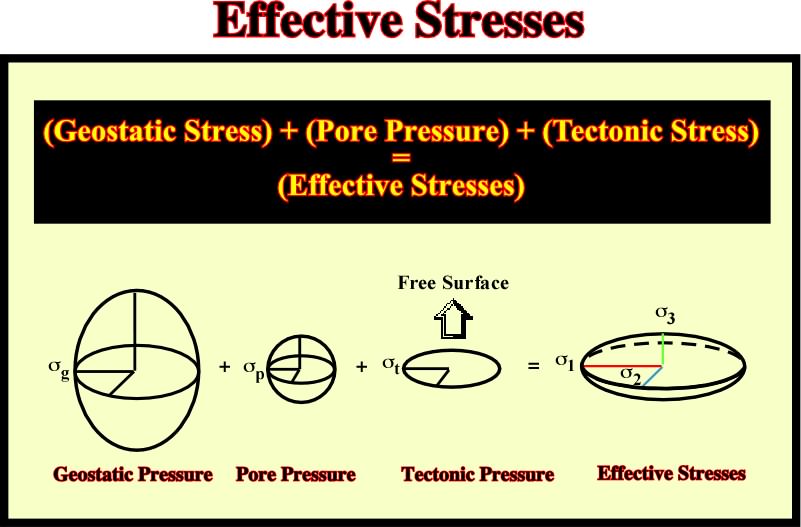
What really deform the sediments are the effective stresses resulting of the combination of the geostatic stress, pore pressure and tectonic stress and not the tectonic stress. The tectonic stress alone, as many people think, is not responsible for deformation. Indeed, with a positive tectonic stress, sediments can be either lengthened or shortened, depending if the geostatic pressure is big enough to impose a vertical maximum effective stress (
1).
Ejective Fold Style (Stille, H., 1917)
Tectonic fold style recognized in the overburden of the Permian Zechstein salt characterized by narrow antiforms and broad, flat-bottomed synforms.
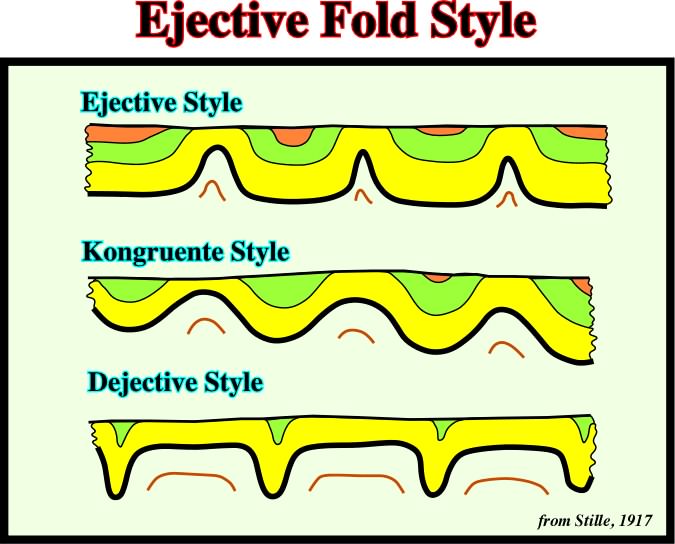
Stille, in 1917, identified three major geometries of folds decoupling over Permian Zechstein salt: (i) Ejective, characterized by narrow antiforms and broad, flat-bottomed synforms, (ii) Kongruent, characterized by an intermediate geometry between the two end-members, and (iii) Dejective, characterized by narrow synforms and broad, flat-topped antiforms.
Folds in an overlapping arrangement. Each fold is relatively short but collectively they form a linear zone, in which the strike of the individual features is oblique to that of the zone as a whole.
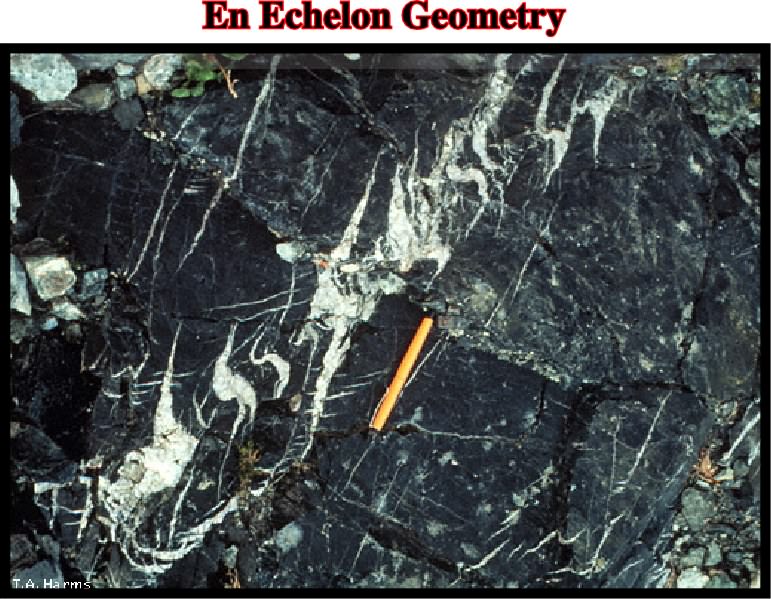
En-échellon geometry is often recognized in small scale tension fractures that occur at an angle to a fault and tend to remain open (open-gash fractures).

En-échellon folds are conical-folds associated with a basement rooted strike-slip faults. During a shortening, induced by a basement rooted strike-slip, depending on the amplitude of the displacement between the faulted blocks, progressively, the sediments show different stages of deformation. In a first step, the sediments are shortened by en-échellon fold, then, the en-échellon folds are faulted by branched strike-slip faults, which are connected with the major deep faults. Finally, when the lateral displacement of the basement blocks is big enough, in surface, the zone of shortening becomes a complex wrench fault, with basement blocks outcropping.
An eustatic unconformity, that is to say, an erosional surface, induced by significant relative sea level falls and locally tectonically enhanced. Synonym of angular unconformity.
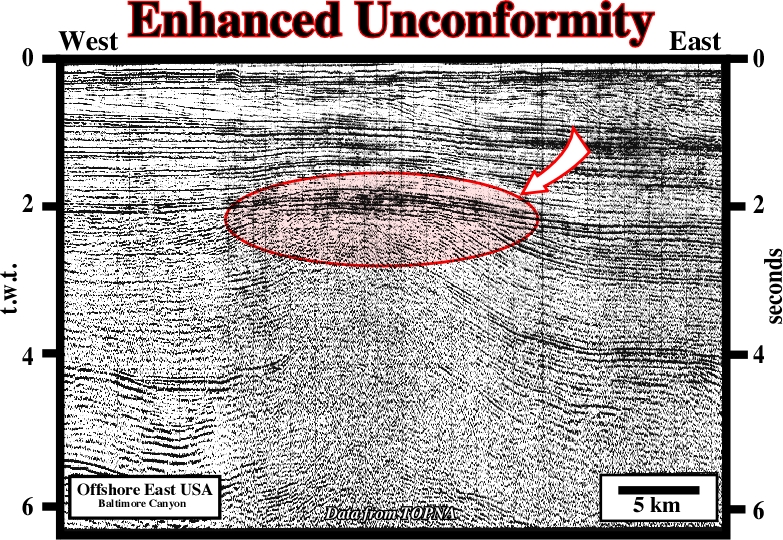
On this seismic line (Baltimore Canyon), there is an eustatic unconformity between the Triassic-Jurassic rift-type basin and the Cretaceous-Cenozoic margin. However, locally, due a volcanic intrusion, this unconformity was tectonically enhanced. Toplap geometric relationships are obvious just above the intrusion, disappear lateral, but they disappear laterally: the enhanced unconformity (angular unconformity) becomes just an unconformity (eustatic unconformity).
Major stratigraphic unity of the Earth's history. There are three main Enothems, which are composed by Erathems. Erathems are composed by Systems, which can include several Series composed by Stages.
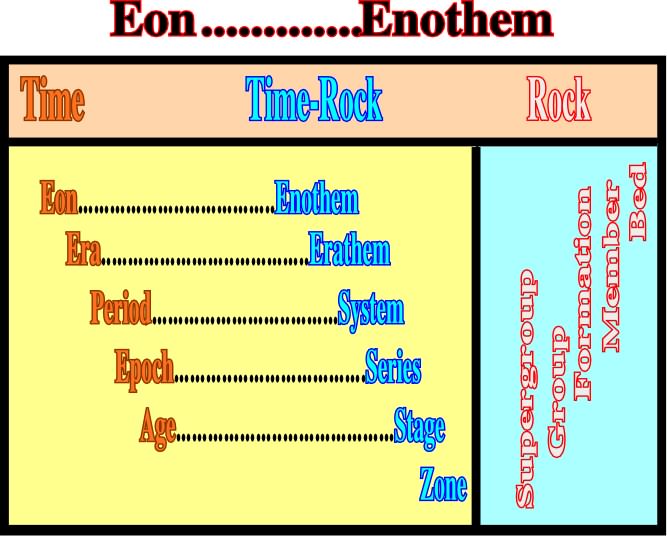
Shenck and Muller (1941) emphasized the fact that rock units have no explicit time connotation by showing them at right angles to the time and time –rock units. The equivalence time units and their corresponding time-rock units is shown above by the dotted lines. Thus, one can say the Cretaceous System consists of all rocks deposited during the Cretaceous Period.
Geological time can be divided in Eons, Eras, Periods, Epochs and Ages. The duration of each Period since Archaeozoic (100 %) is indicated in percentage. The stratigraphic equivalents of the time divisions are: Enothems, Erathems, Systems, Series and Stages.
Intestine-like folds apparently originated mainly by volume changes, such as hydration of anhydrite to gypsum, which involves a 61% increase in volume. Actually, they are associated with: (i) volume changes, (ii) diagenesis, (iii) minor folding by gravity and (iv) large scale folding.
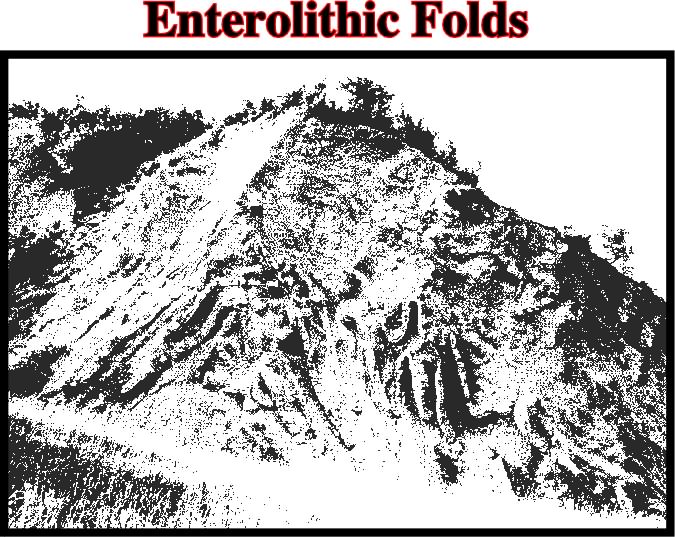
Enterolithic folds, induced by gravity, are abundant in slope environments of the mountains along French-Spanish border.
See: Enothem.
See: Hedreocraton.
Episutural Basin (Bally and Snelson,1980)
Basin located within the megasutures, as Back-arc, Californian-type, Pannonian, Mediterranean, etc..
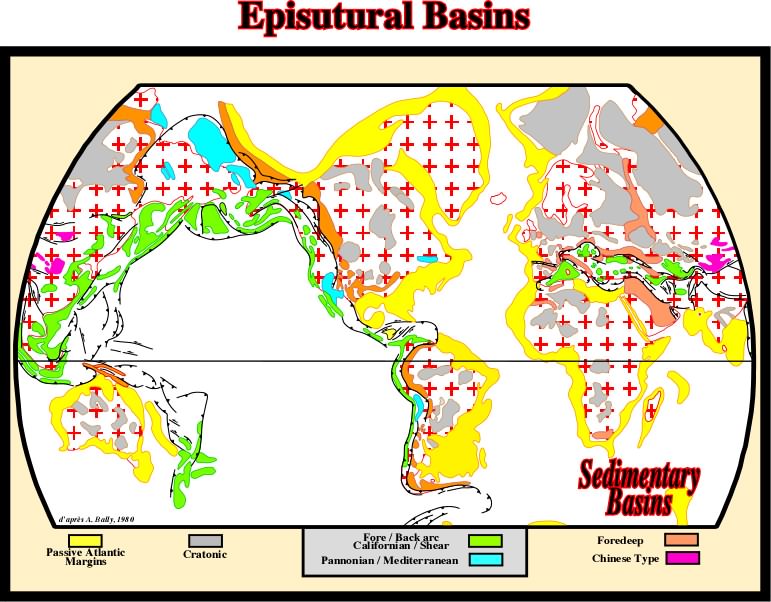
The main episutuiral basins are colored green and blue: (i) Fore-arc and back-arc basin, as their names suggest, are associated with volcanic arcs; (ii) Californian and Shear basins are associated with large lateral displacement; (iii) in Mediterranean-type basins there is oceanization, while in a Pannonian-type there is not.
Extensional tectonic regime characterized by an effective stresses ellipsoid with s1 vertical and s2 and s3 horizontal but equal. The sediments are lengthened by normal faults striking in all azimuths since the ellipsoid is biaxial. It is under this tectonic regime that halokinesis takes place when a significant salt layer is present in the stratigraphic column.
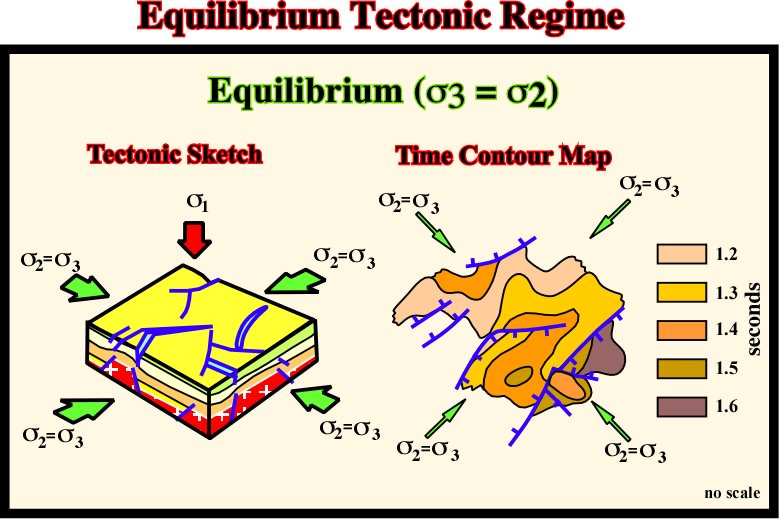
This tectonic regime is often recognized above buried hills (differential compaction), salt domes and volcanic intrusions. Indeed, according to the Mohr's theory, when s1 = s2, faults strike in all direction (radial faults).
See: Enothem.
Synonym of Eustasy. This term is not recommended
The worldwide sea-level regime and its fluctuation, caused by absolute changes in the quantity of seawater (glacio-eutacy) or volume of the oceanic basins. Can be also spelled eustacy.
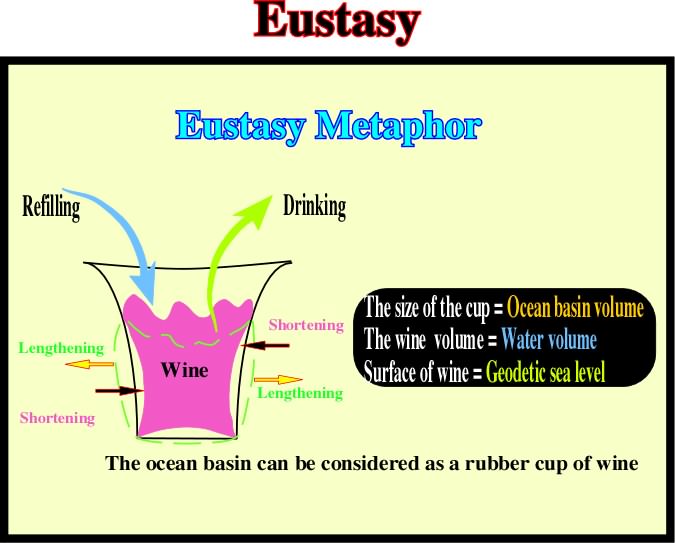
The eustasy can be simulated by the variations of level of wine in a cup (Mörner, 1976). The size of the cup simulates the ocean basin volume, which can be changed by compressing and expanding the cup (earth movements simulation) causing the rise and fall. The rise and fall of the wine's surface simulates tectono-eustasy. The wine volume in the cup can be changed by drinking and refilling (climate); giving rise to corresponding rises and falls in the wine level (glacio-eustasy).
Period of time between two consecutive highs or lows eustatic.
Five orders of eustatic cycles were identified in the geological record. They were designated as 1st to 5th order cycles. First order eustatic cycles correspond to continental flooding cycles defined on the basis of major times of encroachment (landward extension) and restriction of sediments onto the cratons. They are associated with the breakup of supercontinents. They are recognized on all continents and they are believed to be global. Their time duration is higher than 50 My, which Vail takes as the minimum duration for a 1st order cycle. Eustatic cycles of 2nd to 5th order are believed to be caused by smaller magnitude, but higher frequency, and more rapid rates of eustatic change. They cause high frequency variations on the relative change of sea level curve (eustacy + tectonics).
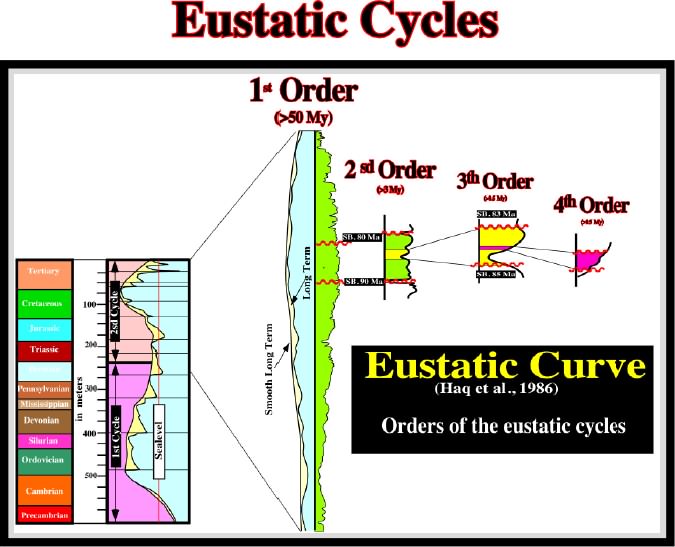
In spite of the fact time duration of the eustatic cycles have changed since the birth of sequential stratigraphy, the majority of geologists assume the following time duration: (1) 3 to 50 My (2) for 2nd order cycles, (3) 0.5 to 3.0 My for 3rd order cycles and (4) 0.1 to 0.4 My for 4th and 5th order cycles. The classification of eustatic cycles into different orders clearly illustrated that P. Vail and co-authors considered Eustasy as a multi-leveled complex geological structure in which each eustatic cycle forms a whole with respect to its parts while at same time being a part of a larger whole (Systemic approach).
A non-clastic sedimentary rock composed primarily of minerals produced from a saline solution as a result of extensive or total evaporation of the solvent. Examples include: gypsum, anhydrite, rock salt, primary dolomite and various nitrates and borates.
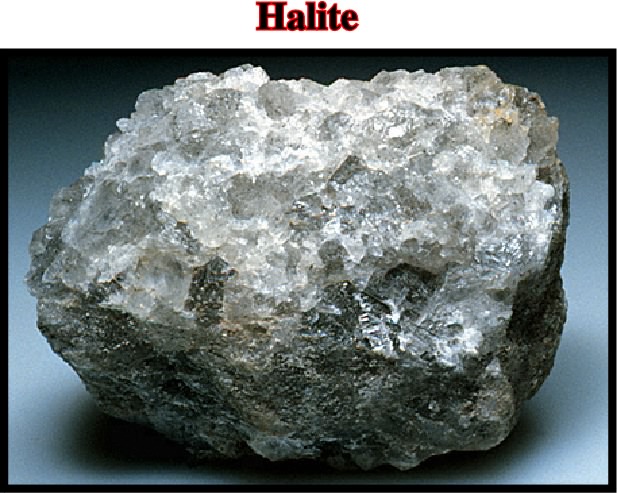
Halite, which is one of the main constituents of evaporites, and particularly the table salt, is typically colorless, but certain occurrences provide red, yellow, blue, etc; colors owing to impurities and /or color centers in the structure.
Roughly it corresponds to a mid-oceanic ridges, which are are elongated, steep-sided elevation of the oceanic floor, along which oceanic accretion takes places by a moving-away of the new material at rates of one to ten centimeters per year.
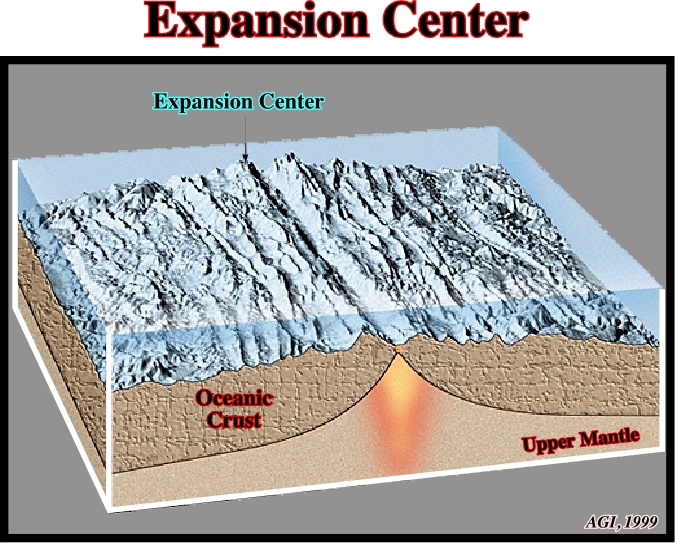
Generally, the expansion centers are located at limit of divergent lithospheric plates, where the astenosphere (upper mantle) is subcropping, as illustrated above.

The majority of the expansion centers are oceanic, but there also subaerial expansion centers with associated lava flows. When an subaerial expansion center become oceanic, the expansion and accretion of the lithospheric plates is made by injection of dikes; it is the onset of the oceanic crust. The vertical geometry of the oceanic crust (volcanic dikes), favors the recognition of the magnetic anomalies, which is not the case when the volcanic crust is composed by lava flows (SDRs), that is to say, when the expansion centers are subaerial.
Tectonic regime characterized by an ellipsoid of effective stresses with the maximum effective stress vertical (
1). Under an extensional tectonic regime, sediments are lengthened by normal faults striking parallel to the medium effective stress (
2).

Extensional tectonic regime can be created with a tectonic stress positive (
t > 0), a tectonic stress nil (
t = 0) and a tectonic stress negative (
t < 0), therefore there is no reason to associated a sedimentary lengthening with the tectonic stress.
Structure in which skirts surround antiformal, infolded synclines of overburden.
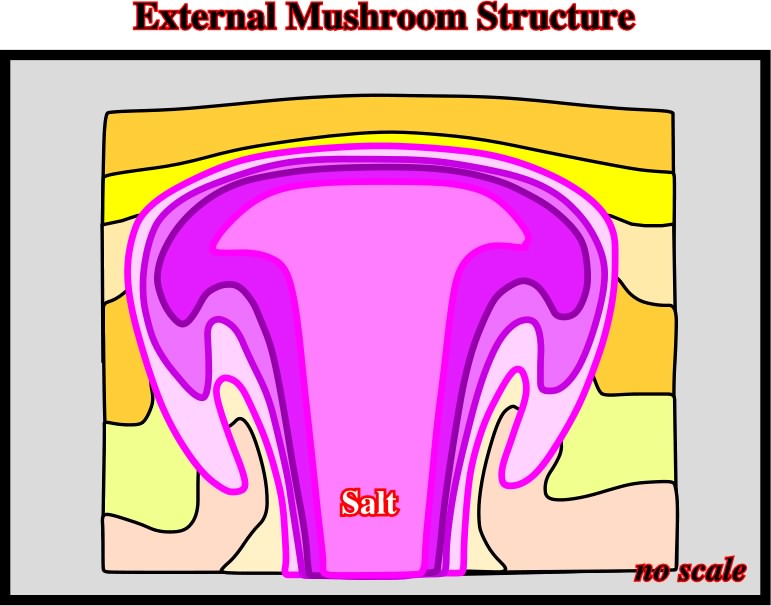
Horizontal section, taken from Jackson, M.P.A. and Talbot, C.J. (1991), through a vortex mushroom diapir showing the anticlines and infolded synclines.
A sheath-like collar around the crest and flanks of a diapir and formed by the rise of the diapir relative to the surrounding overburden. The inner part of the central external shear zone typically comprises ductile evaporites. Depending on the rheology of the overburden, the external part of this shear zone can be a ductile shear zone, a brittle shear zone, a fault, or a growth-fault.
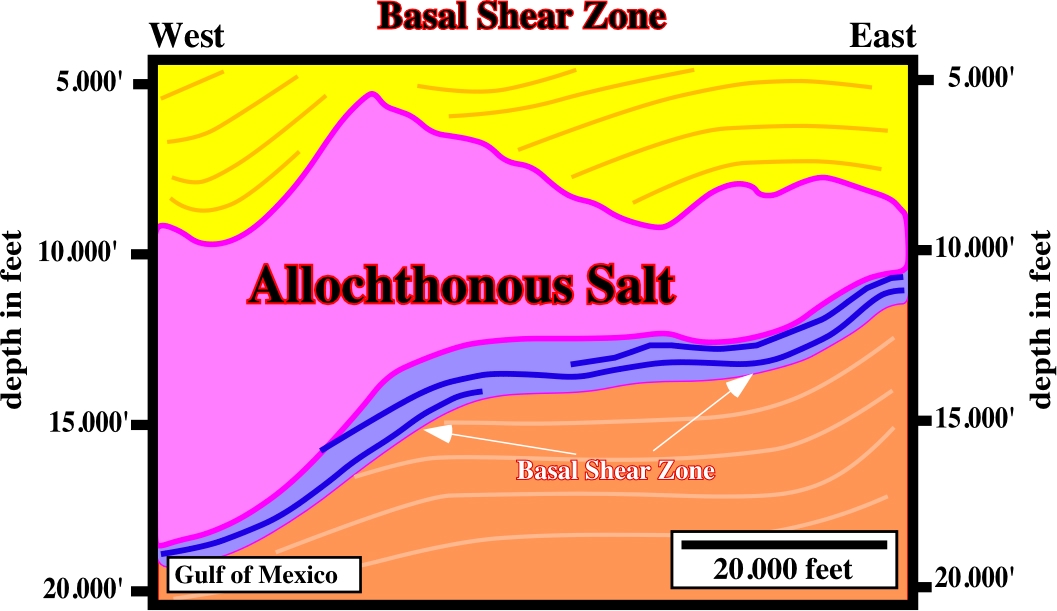
The tectonic disharmony between the sediments above and below the allochthonous salt is quite obvious. The upper sediments are much more deformed than the lower ones. In the Gulf Coast, exploration wells reaching basal shear zones found often an overpressured interval quite difficult to drill.
When salt molding ratios (R°/A°) or flow rate of salt minus dissolution divided by aggradation rate of minus compaction, are in the range 100> R°/A°>10. The dip of the bottom contact flares between 0.6° and about 11.5°.